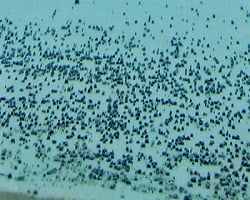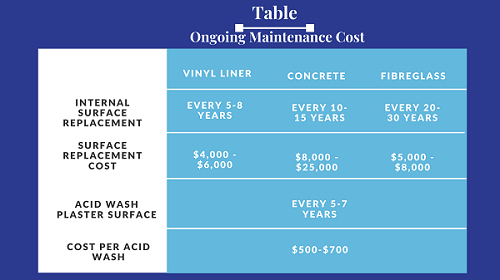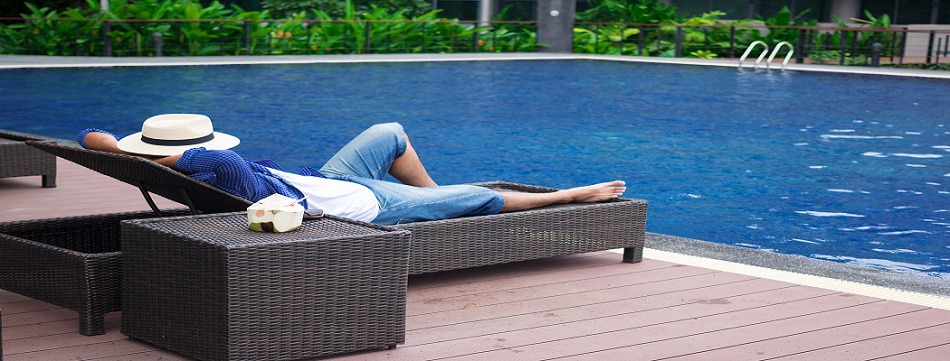What Type Of Pool Is Less Time Consuming To Maintain?
Time spent maintaining a pool means less time having fun in the pool (or quiet time for parents while the kids swim). You don't want your "on pool" time taking away from your "in pool" time.
All pools need maintenance which includes;
1. Sanitising the water – using either salt or chlorine
2. Filtering the water – usually a cartridge or sand filter
3. Cleaning the pool – usually manual, semi-automatic or fully automatic cleaners
4. Maintaining water temperature – usually pool blankets or heat pumps
5. Cleaning the internal and surrounding surfaces

Vinyl Liner
The big plus is a vinyl liner is a smooth surface which makes it harder for algae and bacteria to latch onto. One area to keep an eye on for black spot algae growth is the liner join which usually has a small overlap. As a general rule, vinyl liner pools are pretty easy to maintain as they have less algae and bacteria growth and require less chemicals to keep the water stable and safe to swim in. Good news for you as it means less time going to buy chemicals and carrying them back and forth to the shed and a lower annual maintenance cost.
See the previous sections about needing to replace the liner every 5 – 8 years which naturally takes time to arrange, have installed and incurs further cost to refill and re-sanitise the water with replacement chemicals.
Concrete
As a general rule, concrete pools require more time and use more chemicals to keep the water safe to swim in. Why? The internal surface of a concrete pool is porous with tiny holes that are ideal for microscopic algae and bacteria to grow in. With vigilant water chemistry management and frequent brooming down of the walls and floors, unwanted algae spores can be kept at bay. Black spot algae are commonly associated with concrete pools and once present, is difficult and expensive to remove.
frequent brooming down of the walls and floors, unwanted algae spores can be kept at bay. Black spot algae are commonly associated with concrete pools and once present, is difficult and expensive to remove.
Concrete is naturally high in pH so you’ll regularly use more acid keeping the pH levels in the right range. High pH reduces chlorine effectiveness. Chlorine helps keep algae under control so you’ll most likely use more chlorine compared to other types of pools.
If the pool chemistry isn’t correctly managed, the plaster surface can be slowly eaten away which will shorten the time between resurfacing your pool (usually every 10-15 years which was described in a section above). This also makes the surface rougher on soft feet. Over time, micro thin layers of calcium and other minerals coat the inside of the pool which leads to a dull appearance. An acid wash is usually required every 5 to 7 years to bring back a brighter, newer look (like cut and polishing dull paint on a car). The downside is the diluted muriatic acid removes a thin layer of plaster each time and should only be done by a professional (this is not a watch Youtube and DIY gig to save money thing!). Don’t schedule an acid wash during water restrictions as the entire pool has to be drained and refilled.
Fibreglass
The gel coat in a fibreglass pool is smooth and non-porous which robs algae and bacteria of a place to call home and makes fibreglass pools algae resistant. Depending on the manufacturer, anti-microbial inhibitors can be included (our pools have this included as standard) in the gel coat which further increases protection against bacteria and algae. In the unlikely event of an algae bloom, algae can be permanently and inexpensively removed with a chemical additive.
A quality gel coat finish will also be fade and UV resistant which keeps the surface looking bright without needing acid washes or resurfacing. Generally, a fibreglass pool won’t need resurfacing for at least 20 years if properly maintained.
As fibreglass is inert, it has a neutral effect on the pH balance of the water which requires less chemicals and time to ensure the water is safe. While your concrete pool owning neighbour is spending time brooming down walls and keeping chlorine and pH levels under control, you’ll be on your second Martini sitting by your surprisingly low-maintenance pool wondering what it must be like to scrub the pools walls.

Key Takeaway – Your type of pool surface directly affects the amount of time and effort that goes into keeping your pool clean and safe to swim in. A poorly maintained pool is going to cost a lot of time and money regardless of surface and there is no such thing as a maintenance free pool.
Whether you do it yourself or hire a pool cleaning service, concrete pools require more time and money to maintain than a fibreglass or vinyl liner pool. If you would like to reduce costs and have more “in pool” time than “on pool” time, fibreglass is your best option. If you have the time and do not mind the extra maintenance costs, a concrete pool will bring just as much joy as fibreglass or vinyl liner.
If you want a more forgiving pool for when you have a “I can’t believe I forgot to arrange a pool service while on holiday” moment, fibreglass or vinyl liner is your best bet.
Related Blogs
Installing a pool is a big deal—it’s not just about cooling off on a scorching summer’s day; it’s about creating that ultimate backyard escape where friends and family can make memories for years to....
There’s nothing like stepping into your DIY plunge pool after a long day. You installed it, you love it, and it’s your little slice of paradise. Just like your lawn, your pool isn’t set and forget -....
You're envisioning the perfect backyard—relaxing by a pool that suits your style, your budget, and your maintenance limits. But with so many choices, where do you even begin? Do you go with the....
About The Author
My wife and I grew up playing in swimming pools. Our daughters learnt to swim in our backyard fibreglass swimming pool. There is nothing quite like hearing kids splashing about and giggling. As pools do, our pool became a social magnet for friends, family and neighbours which we loved. Helping customers to have their own pool and saving customers thousands on their pool and equipment is the best job in the world.
























